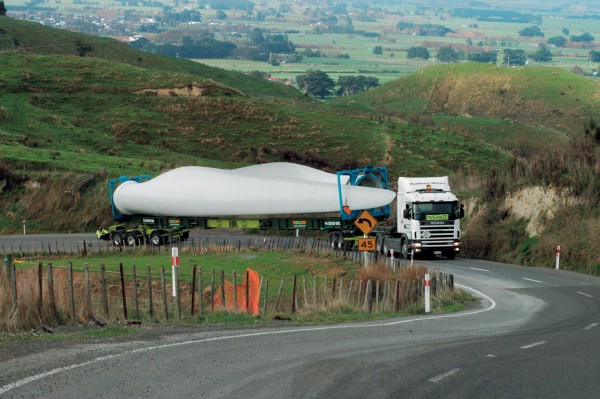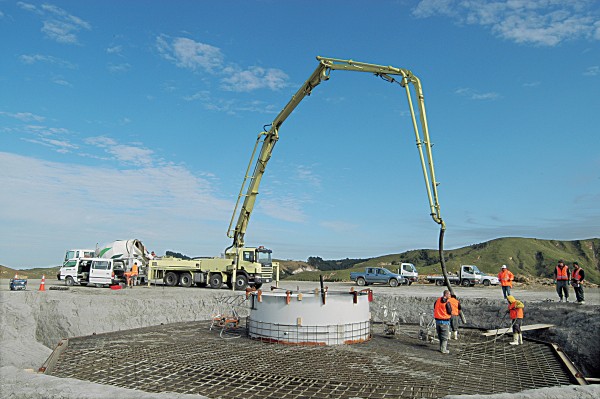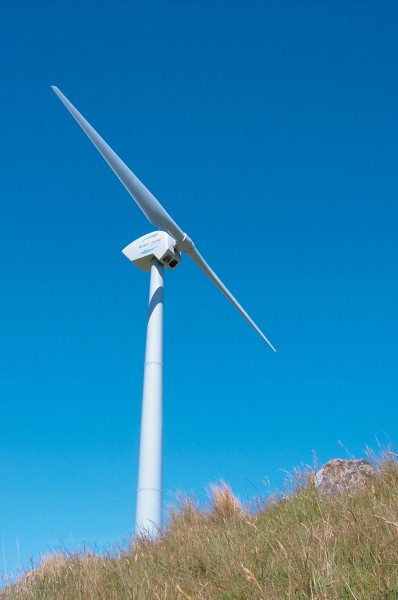
Blowin’ in the wind
The state of wind generated electricity in New Zealand.

New Zealand’s oceanic location, astride the Roaring Forties, endows it with one of the best wind resources in the world. Many sites, particularly in the lower North Island, have the potential, for a given investment, to yield twice the power output of favoured overseas locations, such as the principal wind passes of California.
In 2002, New Zealand Geographic (Issue 57) took a brief look at wind-farm development in New Zealand as part of a general survey of alternative energy sources. Since then the local wind industry has boomed. It is now the fastest-growing energy sector in the country. Wind farms are springing up like mushrooms after summer rain. Major players in the energy industry see wind as able to supply—safely, economically and reliably—up to 20 per cent of the country’s energy needs within the next 10 years.
At the time of the 2002 article, wind power generated 41 megawatts (MW) of electrical power. (1 megawatt = 1 million watts.) Today it contributes 168 MW. Facilities for a further 200 MW have received resource consent in the past 12 months, and those for an additional 500 MW are currently going through the consent process. Feasibility studies and planning for facilities to produce a further 1000+ MW are under way. All going to plan, this entire output should be added to the national grid by 2008.
The potential exists in New Zealand to harness wind to generate power commercially at a rate of at least 8500 gigawatt-hours per year (GWhr/yr), which is about 20 per cent of present annual generation from all sources combined. (1 gigawatt = 1 thousand million watts [1000 megawatts]; 1 gigawatt-hour = a power output of 1 gigawatt maintained for 1 hour.) If the facilities to produce 3000 MW of wind-generated power were to be installed over the next 20 years, the need for a goodly proportion of the additional hydro, geothermal, coal and gas generation projected as being required by 2025 would disappear.
[Chapter-Break]
In 2002, New Zealand had just two multi-turbine wind farms, both in the lower North Island: Hau Nui in the Wairarapa, commissioned in 1996, and Tararua, which came on stream in 1999. Both have recently undergone major increases in capacity.
At Hau Nui, Genesis Energy has added eight new turbines to the original five to increase maximum power output from a modest 3.5 MW to 8.8 MW. At Tararua, Trust-Power has made a much greater commitment to wind. Originally the farm consisted of 48 660-kilowatt (kW) turbines. (1 kilowatt = 1000 watts.) In 2004, the company added 55 more (Stage II) and has since received resource consent for an additional 31 much larger 3 MW turbines, which it plans to erect in 2006 (Stage III). All together, these turbines will be able to generate 161 MW, giving this farm the largest capacity of any in the country.

The Tararua Range wind resource is immense. The annual mean wind speed averages a very high 10 metres per second (m/s) at turbine-hub height. North of the Trust-Power installation, across the Manawatu Gorge, Meridian Energy has installed 55 turbines at Te Apiti wind farm, which opened in 2004. Each has a capacity of 1.65 MW, giving a maximum output of over 90 MW. South of the TrustPower installation, NZ Windfarms will soon have the capacity to generate 48.5 MW from 97 500 kW turbines at Te Rere Hau.
A report released by Transpower in October 2005, Manawatu Wind Generation: Observed impacts on the scheduling and dispatch process, noted that “the amount of wind generation capacity installed in the North Island in three to five years’ time could potentially be in the range of 850 to 1300 MW”.
Te Rere Hau is one of several new wind farms that are to employ New Zealand-made turbines. The first farms relied on Danish-manufactured turbines, but by 2002 engineer and inventor Geoff Henderson, based in Christchurch, was driving the development of a local alternative. In 2003, his company, Windflow Technology, installed his prototype 500 kW two-bladed turbine at Gebbies Pass, between Lyttelton Harbour and Lake Ellesmere. It performed well until destroyed in a violent storm in March 2005, possibly part of a nasty front that had generated a tornado in Greymouth six hours earlier. A modified replacement was mounted on the site in November 2005.
Each of Windflow Technology’s 500 kW turbines can supply sufficient power for approximately 200 households. Over 90 per cent of the components are provided by New Zealand manufacturers, including blades (Wind Blades, Auckland), tower pylon (McCallum Engineering/ACME Engineering, Christchurch), gearbox (A.H. Gears, Auckland), outer cladding (Cresta Composites, Christchurch), hub and pitch mechanism (Farrah Castings, Dunedin), control system (Bremca Industries, Christchurch) and hydraulics (Bosch Rexroth, Christchurch).


At the right price, these modest-sized turbines have the potential to contribute at the lower end of the wind-power market to New Zealand’s self-sufficiency in generating capacity. But Windflow Technology has plans for a bigger model, too, and large turbines with long blades and high towers to match will soon be part of the New Zealand landscape. Puketiro wind farm, north of Wellington, will have 15 1.75 MW turbines operating by the end of 2006, with a further 20 to follow. Meridian intends to have its Whitehill farm, in Southland, whirring with 42 1.65 MW turbines in 2006, while Ventus Energy is seeking resource consent for a farm west of Waitomo with 38 1.75 MW turbines.
Then there are the current Big Daddies of the wind-turbine world, the 3 MW giants; these, too, will be feeding the national grid by the end of 2006. Their nacelles sit atop towers 65–80 m high, while their blade tips can reach up to 125 m above the ground at the highest point of their trajectory. Typically such turbines are spaced 300–500 m apart.
As well as Meridian Energy employing 31 of these titans in Tararua Stage III, Wainui Hills Wind Farms is hoping to have three up and running at Wainuiomata in 2006, while Meridian’s controversial Project West Wind above the village of Makara, behind Wellington, is to use 70. If all goes to plan, 90 more will grace the Titiokura Saddle north-west of Napier when Unison Hydro Tasmania completes its farm there. The resource consent already granted for 48 of the Unison turbines is currently under appeal in the Environment Court, but planning is continuing for the remaining 42.
Perhaps the 120 m tall, 5 MW colossus unveiled in Germany in early 2005 will make an appearance in New Zealand in the not-so-distant future.

Many New Zealander organisations are now involved in the wind-generation game. Along with the major energy suppliers and those companies with vested interests, such as Windflow Technology, there are local bodies, such as Wellington Regional Council, Palmerston North City Council and Eastland Infrastructure (which provides management services to, among others, Eastland Network, the electricity-distribution company for the upper east coast of the North Island), as well as smaller groups of individuals.
Typical of these smaller groups is WindPower Otago, a company that is developing a 25 MW wind farm in the Rock and Pillar Range using Windflow Technology’s 500 kW turbines. The project is funded by local investment obtained largely from Strath Taieri high country farmers. The location was chosen for its high average annual wind speed, its easy road access and its proximity to transmission lines, 12 km away, from the Patearoa power station. All told, at least 19 projects are either nearing completion, about to commence, undergoing consent hearings or at the planning stage (see table and map). But the scene is dynamic and the number will no doubt change within months.
[Chapter-Break]
The introduction of wind farms in New Zealand has not all been plain sailing. The NIMBY syndrome is alive and well. Objections to proposed farms at consent hearings are commonplace, often echoing the detestation detailed at length on the British website www. warmwell.com/windfarms.html. They centre round the industrialisation and uglification of the landscape, the fact that in the UK wind turbines turn only about 25 per cent of the time and hence need non-wind back-up equivalent to 80–90 per cent of capacity, and the sheer numbers of turbines required—tens of thousands—to make much of an impact on energy supply.
Objective discussion of such issues is difficult, particularly given the rapid evolution of wind-turbine technology. On the home front, the industry is represented by the New Zealand Wind Energy Association, which has been conducting a charm offensive along with an educational programme.
While the visual pros and cons of pylons and turbines can be debated ad nauseam, poorly planned wind farms can certainly have an adverse environmental impact. But a big advantage of wind farms is that they share the land on which they stand. Turbines occupy only 3–4 per cent of the space required for a farm, hence are compatible with cropping, grazing, industry and even forestry. Stock grazes contentedly under operating turbines, in the same way as in paddocks alongside a motorway or airport.

Noise has been a significant issue, but today’s turbines are notably quieter than those of even a few years ago. Operational noise depends not just on the model of turbine in question, but also on the layout of the farm, the topography of the area, and the speed and direction of the wind. The principle sounds include broad-band swishing as the blades rotate and hum from the gearbox and generator. In general these sources have decibel ratings similar to those of refrigerators, and conversation can be conducted normally at the base of a turbine running at maximum power output—provided the speakers’ voices can be heard above the wind itself.
The recommended noise limits for wind farms are contained in NZS (New Zealand Standard) 6808:1998, Acoustics—The Assessment and Measurement of Noise from Wind Turbines. On November 17, 2004, Standards New Zealand held a public meeting to determine whether NZS 6808 needed to be changed. Those attending included a lobby group opposed to wind farms; however, when it came to the vote, those present were unanimous in proclaiming NZS 6808 adequate in its current form.
In Europe, where 74 per cent of the world’s wind farms are located, wind turbines stand sometimes within 100 m of houses. In New Zealand a more conservative attitude has prevailed, with turbines generally at three to ten times this distance. And, despite concerns to the contrary, no significant infrasound, or low-frequency noise, is generated by current wind-turbine designs.
The construction of wind farms can damage habitats, while operating wind farms can disturb species sensitive to turbine motion. But, some bad experiences in the 1970s and ’80s notwithstanding, bird and bat mortality from wind turbines has been well-researched and found to be far lower than that from communications towers, homes, commercial buildings, cars or power lines.
The Brooklyn wind turbine on the outskirts of Wellington is less than 20 m from the Karori Wildlife Sanctuary and has been in operation for more than 10 years. During this time there have been no known native-bird or bat deaths. The only fatality has been one blackbird.

At the country’s oldest multi-turbine farm, Hau Nui, the maintenance contract stipulates the monitoring of wildlife deaths associated with the turbines. None has been reported since operations commenced in 1996.
At Tararua, meanwhile, no deaths of native species have been reported since 1999. A Massey University student started a bird-impact study before the Stage II expansion, but abandoned it largely because of a lack of data. Elsewhere, the deaths of a few magpies, gulls and blackbirds have been recorded.
In New Zealand, a wind-farm proposal must include a detailed assessment of the species and habitats present so that, where necessary, the layout can be modified accordingly.
[Chapter-Break]
Economically, wind energy is pretty competitive these days. The Ministry of Economic Development provides comparisons of the costs of generating electricity using renewable resources and fossil fuels. The average capital cost of a typical moderate-sized wind farm is about $2000 per kilowatt of output. By comparison, hydro projects average out at about $3500/kW (and can soar as high as $8000/kW), geothermal installations at about $3000/kW, pulverised-coal plants at $4500/kW and modularised liquid-natural-gas (LNG) turbines at $1500/ kW. Leaving aside the time required to obtain resource consents, of these different systems only gas turbines can be up and running in a time comparable to that in which a typical wind farm can be built.
Once operating and maintenance costs are included, wind generation comes in at $0.06–0.08/kWh, LNG at about $0.10/kWh and coal at $0.08–0.10/kWh.
It is worth noting that carbon credits play a significant part in the economics of New Zealand wind farms. The Crown has allocated carbon credits to wind farm developments and in a 2004 newsletter, Meridian Energy wrote, “This allocation has been one of the important factors in making the project (Te Apiti) commercially viable…The contract will provide an additional revenue stream for Te Apiti and is independent of the Kyoto Protocol entering into force.” In fact, Meridian sold the credits to the Netherlands government, though details are commercially sensitive. Other wind farms have also received these saleable credits.
[Chapter-Break]
What does the future hold ? In 2003 the European Wind Energy Association predicted that by 2010 75,000 MW of electricity would be generated by wind worldwide, and 180,000 MW by 2020, of which 70,000 MW would be generated from turbines sited at sea, a practice yet to be adopted in New Zealand.
Wind power is as much an unfolding story in New Zealand as anywhere else. Whether we want to blow-dry our hair, make a cuppa or keep warm on a winter’s eve, we all want to know electricity is available from the nearest wall socket. The use of wind to keep the supply flowing is on the increase, and appears destined to remain so for the foreseeable future.
















